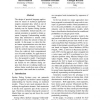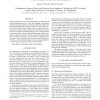312 search results - page 9 / 63 » Classifying Recognition Results for Spoken Dialog Systems |
EMNLP
2009
13 years 5 months ago
2009
The design of practical language applications by means of statistical approaches requires annotated data, which is one of the most critical constraint. This is particularly true f...
ICASSP
2011
IEEE
12 years 11 months ago
2011
IEEE
When human listeners utter Listener Responses (e.g. back-channels or acknowledgments) such as ‘yeah’ and ‘mmhmm’, interlocutors commonly continue to speak or resume their ...
ACL
2004
13 years 9 months ago
2004
We use machine learners trained on a combination of acoustic confidence and pragmatic plausibility features computed from dialogue context to predict the accuracy of incoming n-be...
TREC
2000
13 years 9 months ago
2000
This paper describes our participation in the TREC-9 Spoken Document Retrieval (SDR) track. The THISL SDR system consists of a realtime version of a hybrid connectionist/HMM large...
NCI
2004
13 years 9 months ago
2004
In this paper we demonstrate that Long Short-Term Memory (LSTM) is a differentiable recurrent neural net (RNN) capable of robustly categorizing timewarped speech data. We measure ...


